格拉斯顿伯里山丘上的日出,英格兰 View of Glastonbury Tor from Walton Hill, Somerset, England (© Guy Edwardes/Minden Pictures)
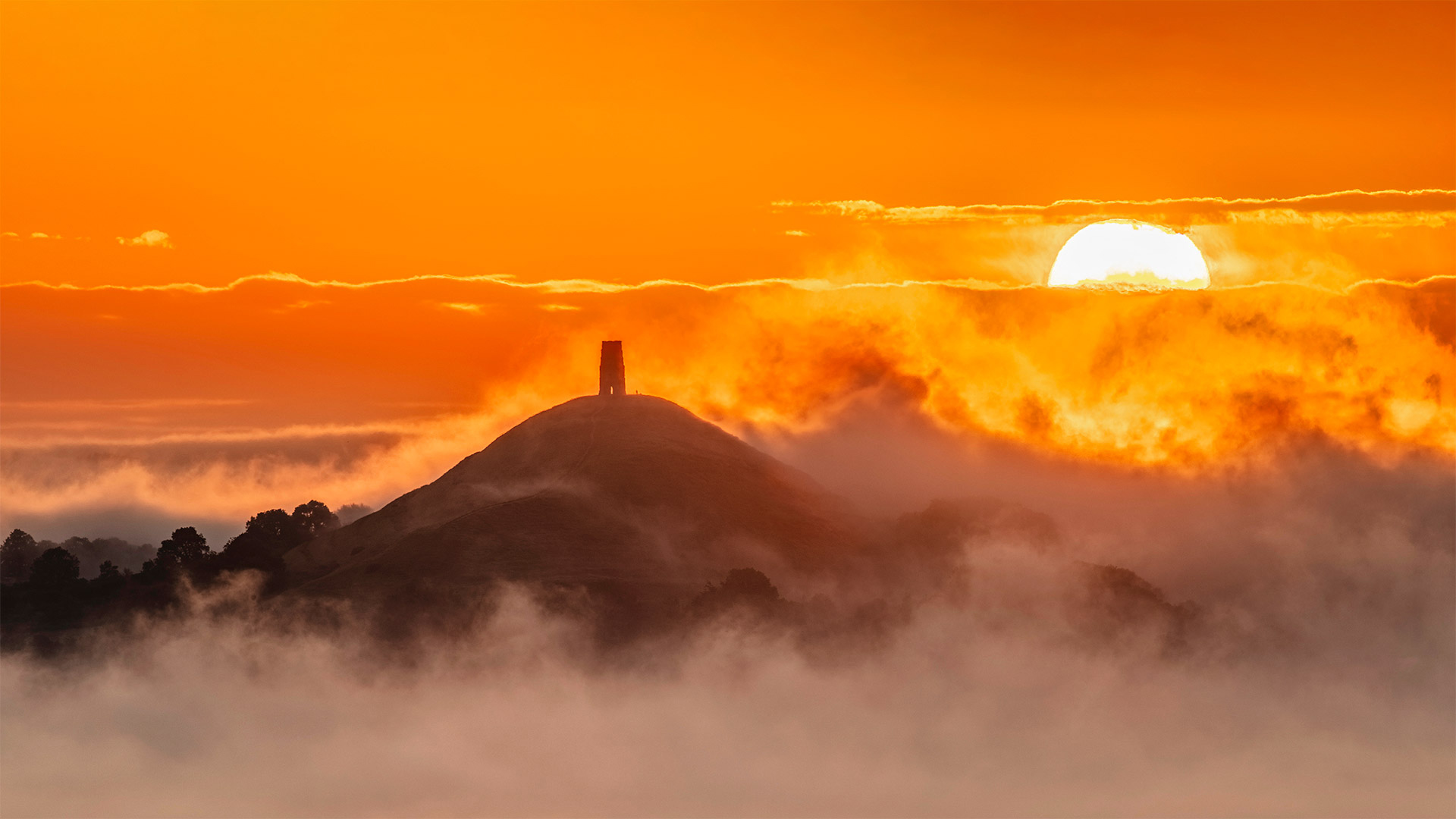
格拉斯顿伯里山丘上的日出,英格兰 View of Glastonbury Tor from Walton Hill, Somerset, England (© Guy Edwardes/Minden Pictures)
夏季来临 Summer a-rising
Summer solstice
The summer solstice, also known as an estival solstice or midsummer, occurs when one of Earth's poles has its maximum tilt toward the Sun. It happens twice yearly, once in each hemisphere (Northern and Southern). For that hemisphere, the summer solstice is when the Sun reaches its highest position in the sky (for areas outside of the tropics) and is the day with the longest period of daylight. Within the Arctic circle (for the northern hemisphere) or the Antarctic circle (for the southern hemisphere), there is continuous daylight around the summer solstice. On the summer solstice, Earth's maximum axial tilt toward the Sun is 23.44°. Likewise, the Sun's declination from the celestial equator is 23.44°.
Since prehistory, the summer solstice has been seen as a significant time of year in many cultures and has been marked by festivals and rituals. Traditionally, in many temperate regions (especially in Europe), the summer solstice is seen as the middle of summer and referred to as "midsummer". Today, however, in some countries and calendars it is seen as the beginning of summer.
夏至
夏至,也被称为夏至或仲夏,发生在地球的两极之一最大程度地向太阳倾斜的时候。每年发生两次,每个半球(北半球和南半球)一次。对于那个半球来说,夏至是太阳在天空中达到最高位置(对于热带以外的地区)的时候,也是日照时间最长的一天。在北极圈(北半球)或南极圈(南半球)内,夏至前后有连续的白天。夏至,地球对太阳的最大轴向倾斜为23.44°。同样,太阳从天球赤道的赤纬为23.44°。
自史前以来,在许多文化中,夏至一直被视为一年中重要的时间,并以节日和仪式为标志。传统上,在许多温带地区(尤其是欧洲),夏至被视为仲夏,被称为“仲夏”。然而,今天,在一些国家和日历中,这被视为夏季的开始。
黄金海岸上的冲浪者,澳大利亚 Surfers catching waves at Palm Beach on the Gold Coast, Queensland, Australia (© Darren Tierney/Getty Images)
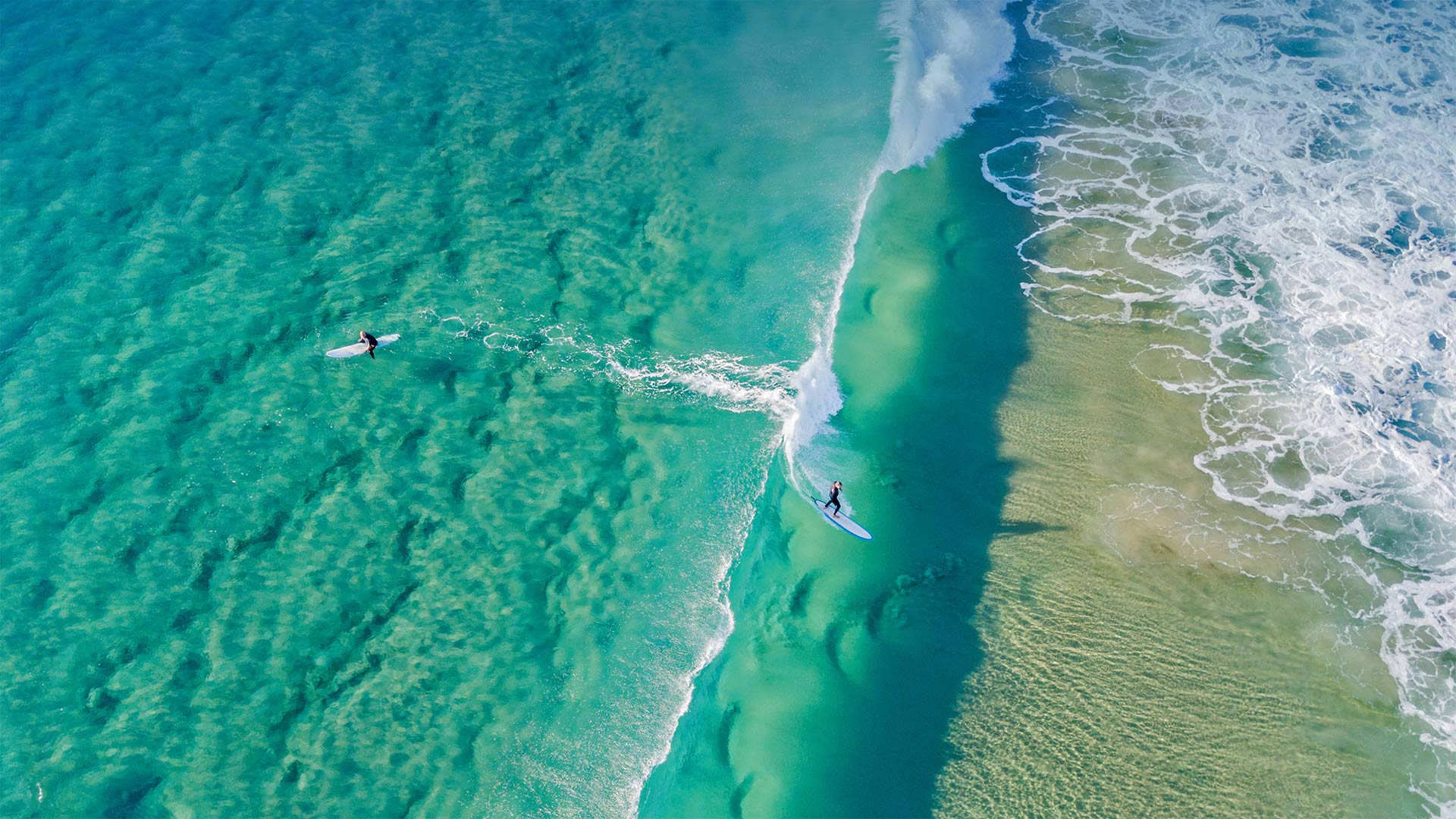
黄金海岸上的冲浪者,澳大利亚 Surfers catching waves at Palm Beach on the Gold Coast, Queensland, Australia (© Darren Tierney/Getty Images)
这是什么水上魔法? What waterborne wizardry is this?
International Surfing Day
Of all the tricks humans have taught themselves, few delight and impress more than surfing. A sport, a pastime, an art, a philosophy of life, surfing is as close to magic as a person can perform on the untamed ocean. Today, the sport of wave riding gets its well-earned due with International Surfing Day, a time each year to honor the sport, the lifestyle of surfing, and the ocean itself, whose good health is vital to the sport and so much else. Surfers have a special connection to the ocean and the waves it produces. A surfable wave relies on so much: The winds hundreds or thousands of miles away that produced the energy to set the swells in motion—those swells might take days to arrive at the shoreline; and then the reef or point of land or underwater boulder upon which a swell will break into a perfectly shaped wave. Wind and timing are everything, and devoted surfers know the weather and the shore intimately.
Surfing can be done anywhere waves break, from Iceland to Ireland, Brazil to Senegal. But there are a handful of spots renowned for their waves, such as Hawaii, Tahiti, California, and the Gold Coast in Queensland, Australia, pictured here. As the sport has evolved, surfers have taken on bigger waves, giants that exceed 50 feet in height at now-famous surf breaks like Jaws, Mavericks, and the latest in Nazare, Portugal.
Surfing is believed to have originated in Polynesia more than 1,500 years ago, most likely in Tahiti and was observed by Westerners as early as the 1700s in Hawaii. Native Hawaiians are credited for creating the sport as we know it today. Duke Kahanamoku, Olympic swimmer, great waterman, and one of Hawaii's earliest celebrities, helped spread surfing's popularity to California and Australia in the early 1900s. Today, surfing is an Olympic sport, has a professional tour for both men and women, and is an integral part of popular culture. But for the lucky souls who know how to ride a wave, it's simply the best way to spend a day at the beach.
国际冲浪日
在人类自学的所有技巧中,很少有比冲浪更让人愉悦和印象深刻的了。冲浪是一项运动,一种消遣,一门艺术,一种人生哲学,就像一个人在未驯服的海洋上所能表演的一样,它离魔法很近。今天,冲浪运动因国际冲浪日而备受青睐,每年的国际冲浪日都是纪念这项运动、冲浪生活方式和海洋本身的日子,海洋本身的健康对这项运动和其他许多运动都至关重要。冲浪者与海洋及其产生的波浪有着特殊的联系。冲浪的波浪依赖于这么多:数百或数千英里以外的风产生的能量使涌浪运动,这些涌浪可能需要几天才能到达海岸线;然后是礁石或陆地或水下巨砾的点,在其上,涌浪将变成完美形状的波浪。风和时间是一切,热衷于冲浪的人对天气和海岸了如指掌。
从冰岛到爱尔兰,从巴西到塞内加尔,冲浪可以在任何波涛汹涌的地方进行。但也有一些以海浪闻名的景点,如夏威夷、塔希提、加利福尼亚和澳大利亚昆士兰的黄金海岸,如图所示。随着这项运动的发展,冲浪者们已经开始接受更大的海浪,在如今著名的冲浪休息处,身高超过50英尺的巨人,如大白鲨、小牛队,以及最近在葡萄牙的纳粹队。
据信,冲浪运动起源于1500多年前的波利尼西亚,最有可能发生在塔希提岛,早在17世纪,西方人就在夏威夷观察到了冲浪运动。据我们今天所知,夏威夷土著人创造了这项运动。20世纪初,奥林匹克游泳运动员、伟大的沃特曼、夏威夷最早的名人之一杜克·卡哈纳莫库(DukeKahanamoku)帮助将冲浪运动普及到加利福尼亚和澳大利亚。今天,冲浪是一项奥林匹克运动,男女都有专业的巡回赛,是流行文化的一个组成部分。但对于那些懂得乘风破浪的幸运儿来说,这是在海滩度过一天的最佳方式。
山下盛开的箭叶脂根菊,美国大提顿国家公园 Balsamroot wildflowers bloom below the Teton Mountains in Grand Teton National Park, Wyoming (© Mike Cavaroc/Tandem Stills + Motion)
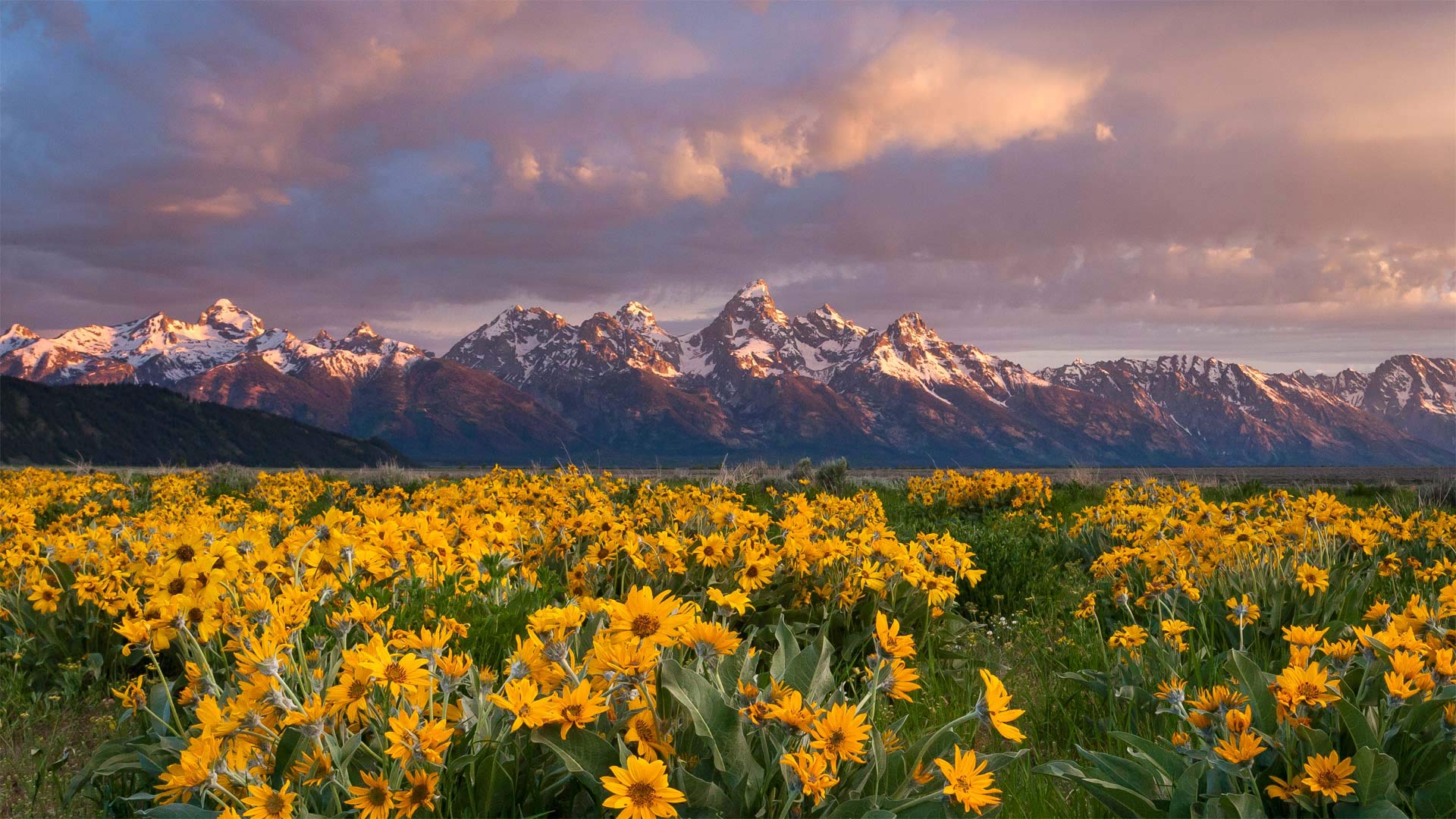
山下盛开的箭叶脂根菊,美国大提顿国家公园 Balsamroot wildflowers bloom below the Teton Mountains in Grand Teton National Park, Wyoming (© Mike Cavaroc/Tandem Stills + Motion)
壮丽的景色 A grand view
Grand Teton National Park
These arrowleaf balsamroot wildflowers, commonly known as Oregon sunflowers, have a grand view of the Grand Tetons from the valley below the towering range. The region's harsh weather means that only the hardiest of wildflowers can survive, and the bright yellow arrowheads fit the bill. The plants are drought tolerant, winter hardy, tenacious against trampling, and even fire resistant, with a taproot which regenerates leaves and flowers after the top has burned.
Located just 10 miles from Yellowstone National Park, Grand Teton National Park and the surrounding national forests constitute the almost 18-million-acre (28,000-square-mile) Greater Yellowstone Ecosystem, one of the world's largest intact mid-latitude temperate ecosystems. There's something for every lover of the outdoors here, and the park is a popular destination for mountaineering, hiking, fishing, and other forms of recreation, with more than 1,000 drive-in campsites and over 200 miles of hiking trails that provide access to backcountry camping areas. Grand Teton National Park is one of the 10 most popular parks in the United States.
大提顿国家公园
这些箭叶香根野花,俗称俄勒冈州向日葵,从高耸山脉下方的山谷中可以俯瞰大提顿。该地区恶劣的天气意味着只有最顽强的野花才能生存,而明亮的黄色箭头正好符合这一要求。这些植物耐旱、耐寒、抗践踏、甚至耐火,主根在顶部燃烧后再生叶子和花朵。
大提顿国家公园距离黄石国家公园仅10英里,它和周围的国家森林构成了近1800万英亩(28000平方英里)的大黄石生态系统,是世界上最大的完整中纬度温带生态系统之一。这里有适合每一位户外爱好者的东西,公园是登山、徒步旅行、垂钓和其他娱乐形式的热门目的地,有1000多个免下车露营地和200多英里的徒步小道,可以进入偏远的露营区。大提顿国家公园是美国十大最受欢迎的公园之一。
仙岩寺中的升仙桥,韩国曹溪山道立公园 Seungseon Bridge at Seonam Temple in Jogyesan Provincial Park, South Korea (© Aaron Choi/Getty Images)
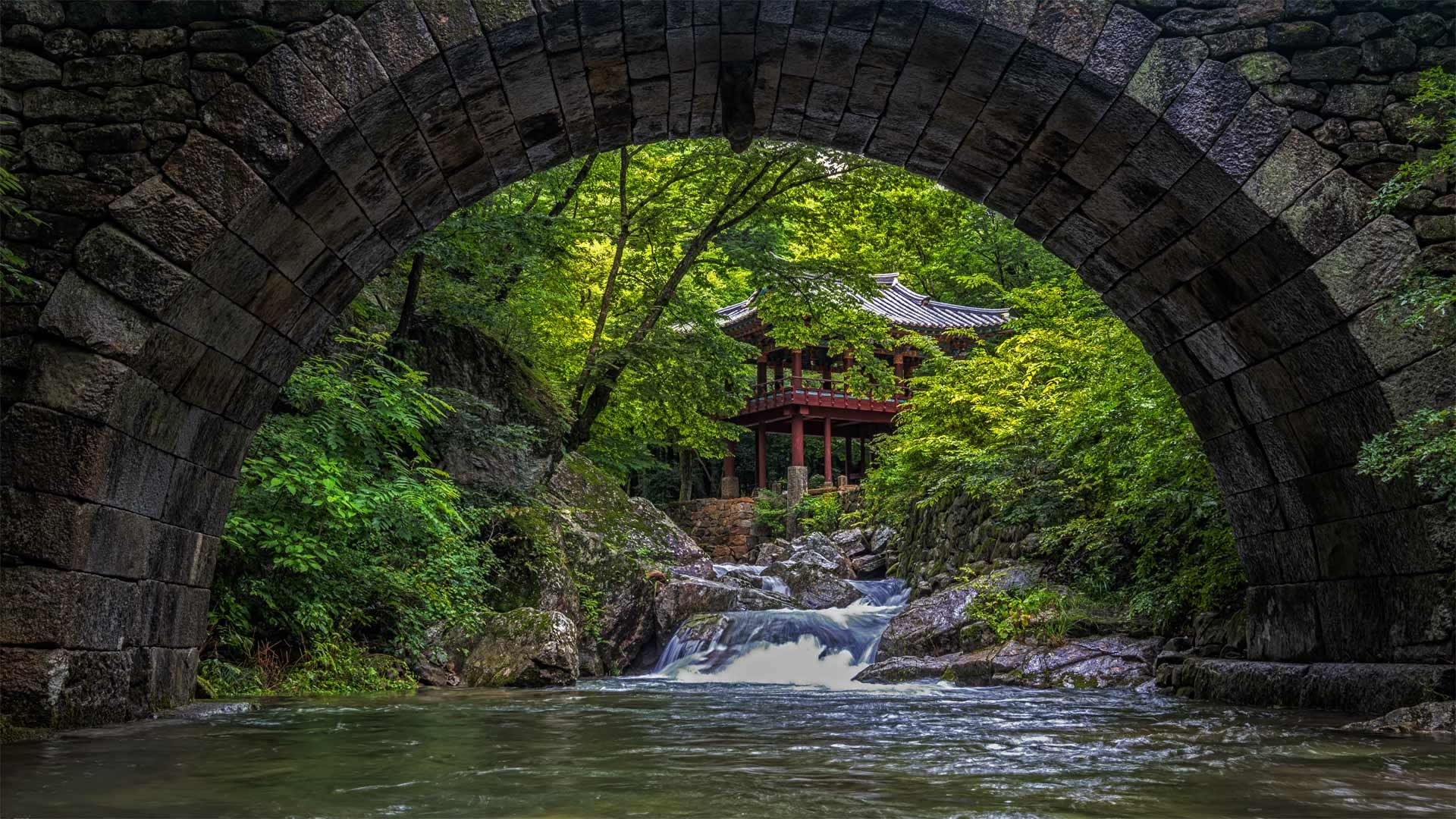
仙岩寺中的升仙桥,韩国曹溪山道立公园 Seungseon Bridge at Seonam Temple in Jogyesan Provincial Park, South Korea (© Aaron Choi/Getty Images)
连接过去和现在 Bridging past and present
Seonam Temple, South Korea
The Seonam Temple, or Seonamsa, in Jogyesan Provincial Park, South Korea, is famed for expressing calm serenity. Just downstream, Buddhist monks built this gently arched bridge by hand centuries ago. Stones around the base record the names of visitors for posterity. Called the Seungseon Bridge ('the Ascending Immortals'), it's fitting to approach the temple itself on foot, at one with nature. The site is hidden away in ancient trees, with tranquil ponds and streams, gentle hiking trails, and gorgeous pagodas. The temple still ekes out its day in the traditional way, with mellow bells and meditation. The monks also cultivate wild tea plants and are happy to share the benefits of the harvest. You are at peace as soon as you arrive at Seonamsa, and there's little to distract you from the present moment.
The original temple is believed to have been built in the 9th century, but over the years war and a major fire caused extensive damage, and it had to be rebuilt in the 19th century. Now the Seonam Temple is a UNESCO World Heritage Site, along with six other 'sansa,' or Buddhist monasteries, dotted in the mountains throughout the southern provinces of the Korean Peninsula. Visitors are invited to stay overnight at the temple and follow the monks' daily practice, but you can also dip in for a day to absorb the peace and tranquility. Flowers in spring and colorful leaf displays in fall make those the most popular times to visit.
韩国色南寺
位于韩国Jogyesan省立公园的Seonam庙(Seonamsa)以表达平静而闻名。就在下游,佛教僧侣在几个世纪前手工建造了这座轻轻的拱桥。基地周围的石头为后人记录了游客的名字。这座名为Seungseon Bridge(“升天神仙”)的桥适合步行接近寺庙本身,与大自然融为一体。该遗址隐藏在古树丛中,有宁静的池塘和溪流,温和的徒步小道,还有华丽的宝塔。这座寺庙仍然以传统的方式,用柔和的钟声和冥想来维持它的一天。僧侣们还种植野生茶树,并乐于分享收获的好处。你一到达梭南沙就很平静,没有什么可以分散你对当下的注意力。
据信,原来的寺庙建于9世纪,但多年来,战争和一场大火造成了巨大的破坏,不得不在19世纪重建。现在,色南寺与其他六座“三萨”或佛教寺院一起被联合国教科文组织列为世界遗产,分布在朝鲜半岛南部各省的山区。游客被邀请在寺庙过夜,并遵循僧侣们的日常修行,但你也可以泡一天来吸收和平与宁静。春天的鲜花和秋天五颜六色的树叶展览使这些地方成为最受欢迎的游览时间。
大雾山国家公园,田纳西州 Great Smoky Mountains National Park, Tennessee (© Tony Barber/Getty Images)
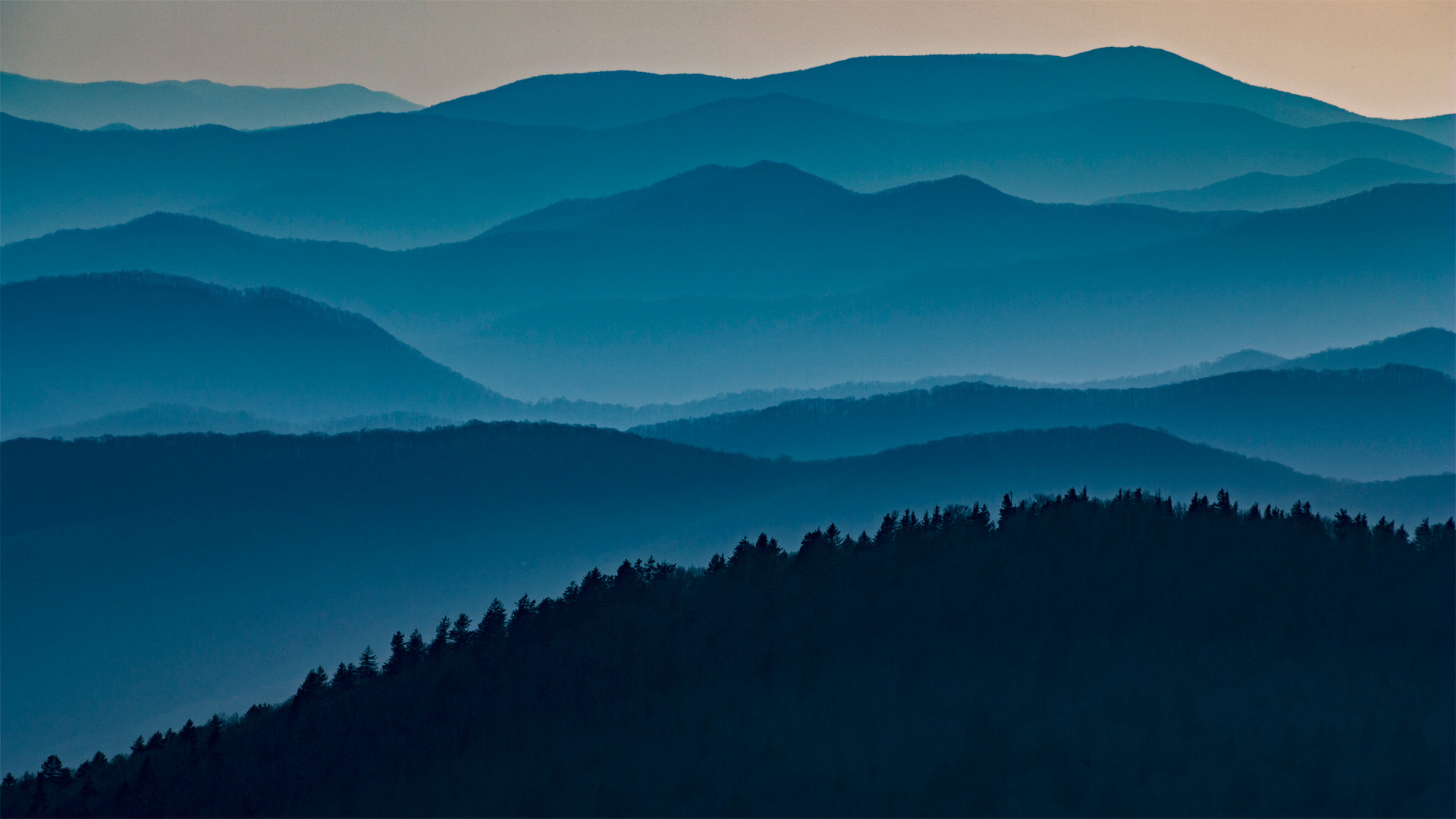
大雾山国家公园,田纳西州 Great Smoky Mountains National Park, Tennessee (© Tony Barber/Getty Images)
田纳西之巅 The top of Tennessee
Nature Photography Day in the Smokies
If you're celebrating Nature Photography Day today, then Great Smoky Mountains National Park would be an excellent place to snap your own shots of sylvan splendor like this one. That's because you'd have two reasons to celebrate—the park turns 88 today. These misty peaks and valleys along the border between Tennessee and North Carolina were established as a national park on this day in 1934. All these years later, it may not be the most famous national park in the US, but it is by far the most popular. With more than 14 million visitors per year, it draws more people than the Grand Canyon, Yellowstone, and Yosemite combined.
True to its name, the park is known for its persistent haze. Native Americans–the region is the ancestral home of the Cherokee people–gave the place a name that translates to 'place of the blue smoke.' The smoke is actually a fog created in part by the native vegetation. It owes its blueish appearance to humidity and stagnant air. Almost all of the park is covered in deciduous and coniferous forest, a third of it old-growth trees that predate European settlement. The thick forests, range of elevations, and abundant rainfall support a stunning variety of wildlife. There are so many black bears that about two live in every square mile of the park. Bats, foxes, skunks, otters, bobcats, and 200 species of birds also call this place home. The park is most notable for its salamanders. In fact, it's known as the Salamander Capital of the World, with 30 species living here.
But the real stars of the park are the mountains. For panoramic vistas, this vantage point—Clingman's Dome on the Tennessee side of the park—is hard to beat. At 6,643 feet, it's also the highest point in the state. To take your own version of this shot, you don't even have to hike. Simply drive to the parking lot. But after you've got your pics, keep the camera handy. If the parking lot looks this good, imagine what photos you can take in the rest of the park.
烟雾中的自然摄影日
如果你今天要庆祝自然摄影日,那么大烟山国家公园将是一个很好的地方,你可以在这里拍摄自己的森林美景。那是因为今天你有两个理由庆祝公园88岁生日。1934年的今天,沿着田纳西州和北卡罗来纳州边界的这些雾蒙蒙的山峰和山谷被建成了国家公园。多年后,它可能不是美国最著名的国家公园,但它是迄今为止最受欢迎的国家公园。它每年吸引的游客超过1400万,超过了大峡谷、黄石公园和约塞米蒂的总和。
不折不扣地说,这个公园以其持续的阴霾而闻名。印第安人——该地区是切罗基人的祖籍——给这个地方起了一个翻译成“蓝烟之地”的名字烟雾实际上是一种雾,部分是由当地植被造成的。它的蓝色外观归因于潮湿和停滞的空气。几乎整个公园都覆盖着落叶和针叶林,其中三分之一是欧洲殖民地之前的老树。茂密的森林、广阔的海拔和充足的降雨量支撑着种类繁多的野生动物。公园里有很多黑熊,每平方英里大约有两只。蝙蝠、狐狸、臭鼬、水獭、山猫和200种鸟类也把这里称为家。该公园以其蝾螈最为著名。事实上,这里被称为世界蝾螈之都,有30种蝾螈生活在这里。
但公园里真正的明星是山。从全景来看,这个位于公园田纳西州一侧的有利位置克林曼圆顶(Clingman's Dome)是无与伦比的。海拔6643英尺,也是该州的最高点。要拍摄你自己的照片,你甚至不需要徒步旅行。只需开车去停车场。但是在你拿到照片后,把相机放在手边。如果停车场看起来这么好,想象一下你可以在公园的其他地方拍些什么照片。
纽约大都会艺术博物馆 The Metropolitan Museum of Art in New York City (© Susanne Pommer/Shutterstock)
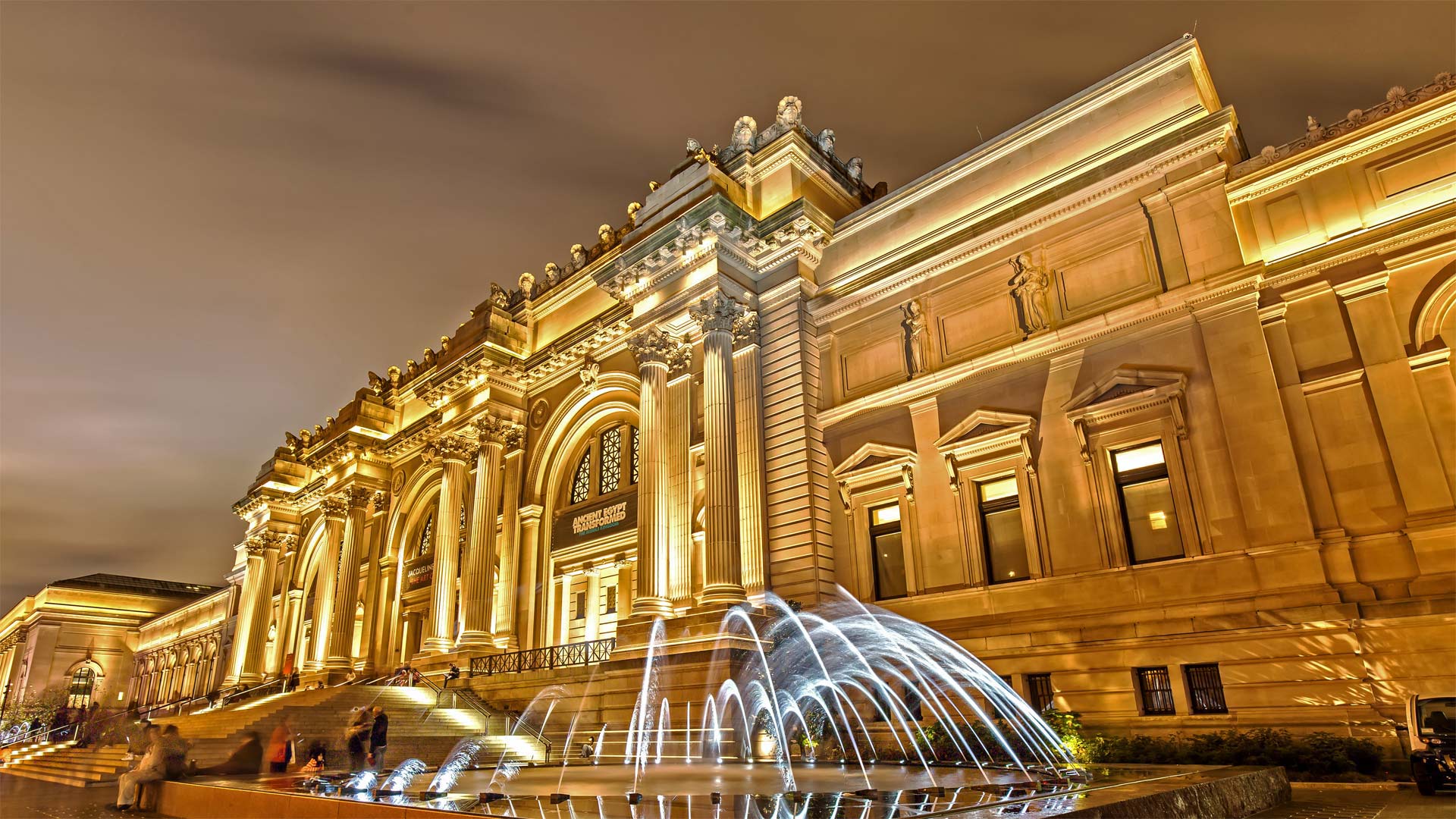
纽约大都会艺术博物馆 The Metropolitan Museum of Art in New York City (© Susanne Pommer/Shutterstock)
当地人把这个地方简称为“大都会博物馆” Locals know this place simply as 'the Met'
Museum Mile Festival
New York City's Metropolitan Museum of Art, known informally as the Met, is one of the world's preeminent museums. Perhaps no other art museum in the world commands more recognition, except the Louvre in Paris. The Met anchors Museum Mile, a stretch of Fifth Avenue on Manhattan's Upper East Side that is home to eight museums. The Met is the biggest, followed by the Guggenheim. All reside within 22 blocks of one another. Today, the city celebrates these curatorial treasures with the Museum Mile Festival, as museums extend their hours and offer free admission to all visitors. Billed as a mile-long celebration of art and culture, the festival also includes outdoor performances along Fifth Avenue.
The Met was founded in 1870 and backs up to the eastern perimeter of Central Park. Its encyclopedic collection includes art from every part of the world, from classical antiquities to modern art, musical instruments, weaponry, clothing, and even an Egyptian temple, the Temple of Dendur, which was dismantled by Egypt in 1965 and given to the US. The Met is also famous for hosting the Costume Institute Gala, better known as the Met Gala, on the first Monday of May. The gala is organized by Vogue magazine and draws celebrities from many fields.
But you don't have to be an A-lister to enjoy Museum Mile today. So, if your jam is the Met, El Museo del Barrio, the Jewish Museum, or the Cooper-Hewitt, you don't want to miss this massive block party.
五大道博物馆节
纽约大都会艺术博物馆,俗称大都会博物馆,是世界上最杰出的博物馆之一。也许除了巴黎的卢浮宫,世界上没有其他艺术博物馆能获得更多的认可。大都会博物馆位于曼哈顿上东区第五大道的一段,是八家博物馆的所在地。大都会是最大的,其次是古根海姆。它们都居住在彼此相隔22个街区的范围内。今天,随着博物馆延长营业时间并向所有游客提供免费入场券,该市将通过博物馆英里节来庆祝这些馆藏珍品。被誉为长达一英里的艺术和文化庆典,该节日还包括沿第五大道的户外表演。
大都会公园建于1870年,位于中央公园东侧。其百科全书式的收藏包括来自世界各地的艺术,从古典古董到现代艺术、乐器、武器、服装,甚至还有一座埃及寺庙,即登杜尔神庙,该神庙于1965年被埃及拆除并赠送给了美国。大都会还因在5月的第一个星期一举办服装学院晚会而闻名,更广为人知的是大都会晚会。该晚会由《Vogue》杂志组织,吸引了来自多个领域的名人。
但你不必非得成为一线明星才能享受今天的博物馆里程。所以,如果你的果酱是大都会博物馆(Met)、El Museo del Barrio、犹太博物馆(Jewish Museum)或库珀·休伊特(Cooper Hewitt),你一定不想错过这个大规模的街区聚会。
大弯曲国家公园的塞拉庞塞和格兰德河边的悬崖,美国得克萨斯州 Cliffs of the Sierra Ponce and Rio Grande River, Big Bend National Park, Texas (© Tim Fitzharris/Minden Pictures)
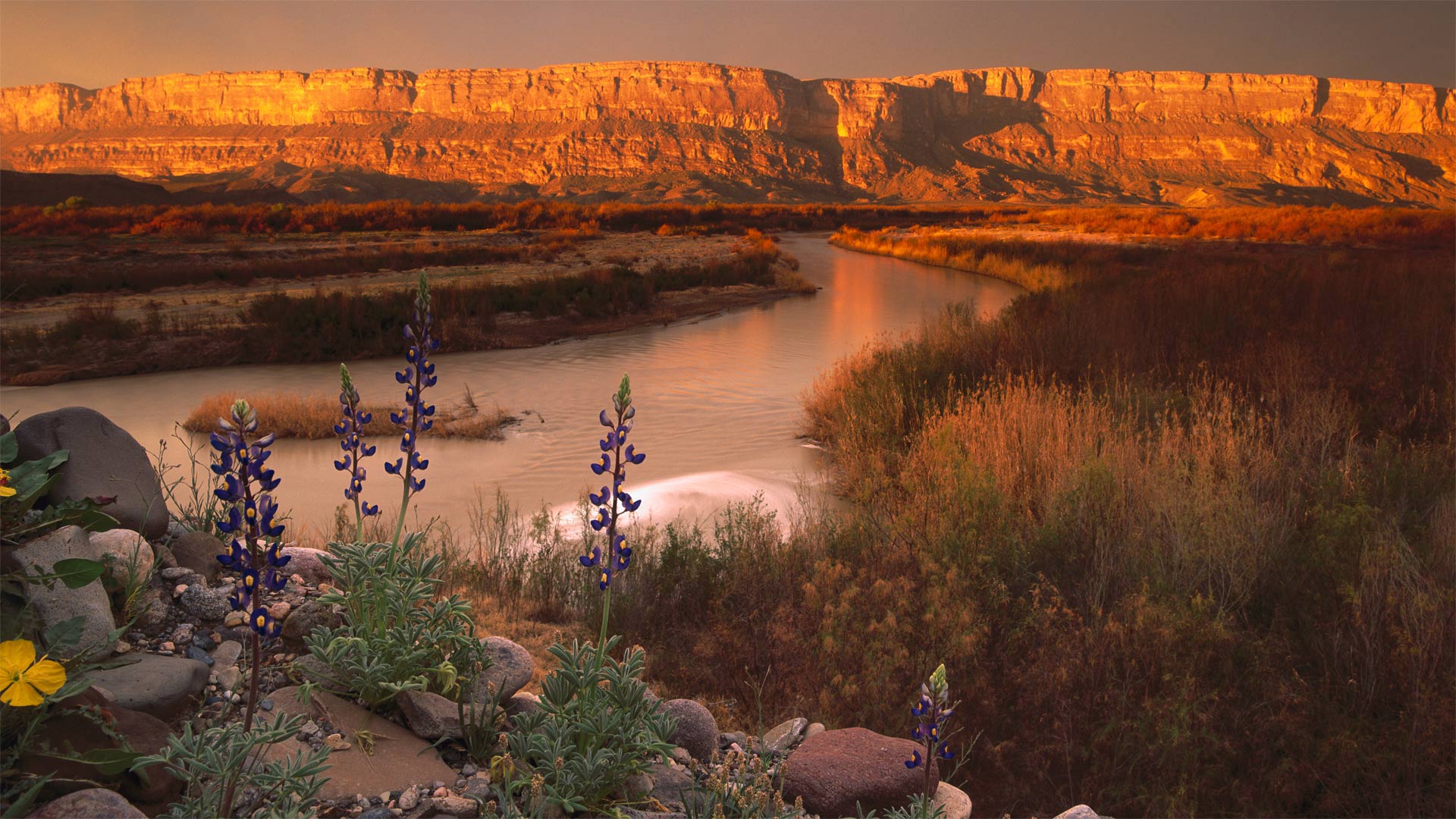
大弯曲国家公园的塞拉庞塞和格兰德河边的悬崖,美国得克萨斯州 Cliffs of the Sierra Ponce and Rio Grande River, Big Bend National Park, Texas (© Tim Fitzharris/Minden Pictures)
奇瓦瓦沙漠中的一处偏远绿洲 A remote oasis in the Chihuahuan Desert
Big Bend National Park turns 78
Join us for a hike at one of America's least-visited national parks. Big Bend National Park may be among the country's largest national parks with an area of over 800,000 acres (about the area of Rhode Island), but it's also one of the most remote. Found in West Texas along the Rio Grande at the Mexico border, the park entrance is roughly a two-hour drive from the nearest interstate. The good thing is, even in a 'busy' year when half a million people visit, there's plenty of space to enjoy the great outdoors unhindered by crowds.
Added to the national park system on this day in 1944, Big Bend contains the largest protected area of the Chihuahuan Desert in the United States. It's also known for having the darkest night skies among the contiguous states. This makes it a 'must visit' for stargazing; thousands of stars are visible when the skies are clear, along with the Milky Way. If you head out for a hike, keep your eyes peeled for the 1,200 plant species in the park. There are also plenty of animals, though most of them tend to come out only at night. Except birds, that is. Birdwatching is incredibly popular at Big Bend–it's on the paths of annual migrations, so more than 450 different bird species have been cataloged here.
大弯国家公园78岁
加入我们,在美国游客最少的国家公园之一徒步旅行。大弯国家公园可能是美国最大的国家公园之一,面积超过800000英亩(大约相当于罗德岛的面积),但它也是最偏远的国家公园之一。公园入口位于得克萨斯州西部,沿墨西哥边境的格兰德河,距离最近的州际公路大约两小时车程。好消息是,即使是在50万人来访的“繁忙”年份,也有足够的空间来享受美妙的户外活动,不受人群的阻碍。
1944年的今天,大本德被纳入国家公园系统,是美国最大的奇瓦瓦沙漠保护区。它还因拥有邻近各州中最黑暗的夜空而闻名。这使得它成为观星的“必到之地”;当天空晴朗时,数千颗恒星与银河系一起可见。如果你要去远足,一定要留意公园里的1200种植物。这里也有很多动物,尽管它们大多只在晚上出来。就是说,除了鸟。大本德的观鸟活动非常受欢迎,因为每年都有鸟类迁徙,所以这里有450多种不同的鸟类。
米苏尔岛,拉贾安帕特群岛中的岛屿,印度尼西亚 Misool Island, one of the four major islands in the Raja Ampat Islands in West Papua, Indonesia (© rusm/Getty Images)
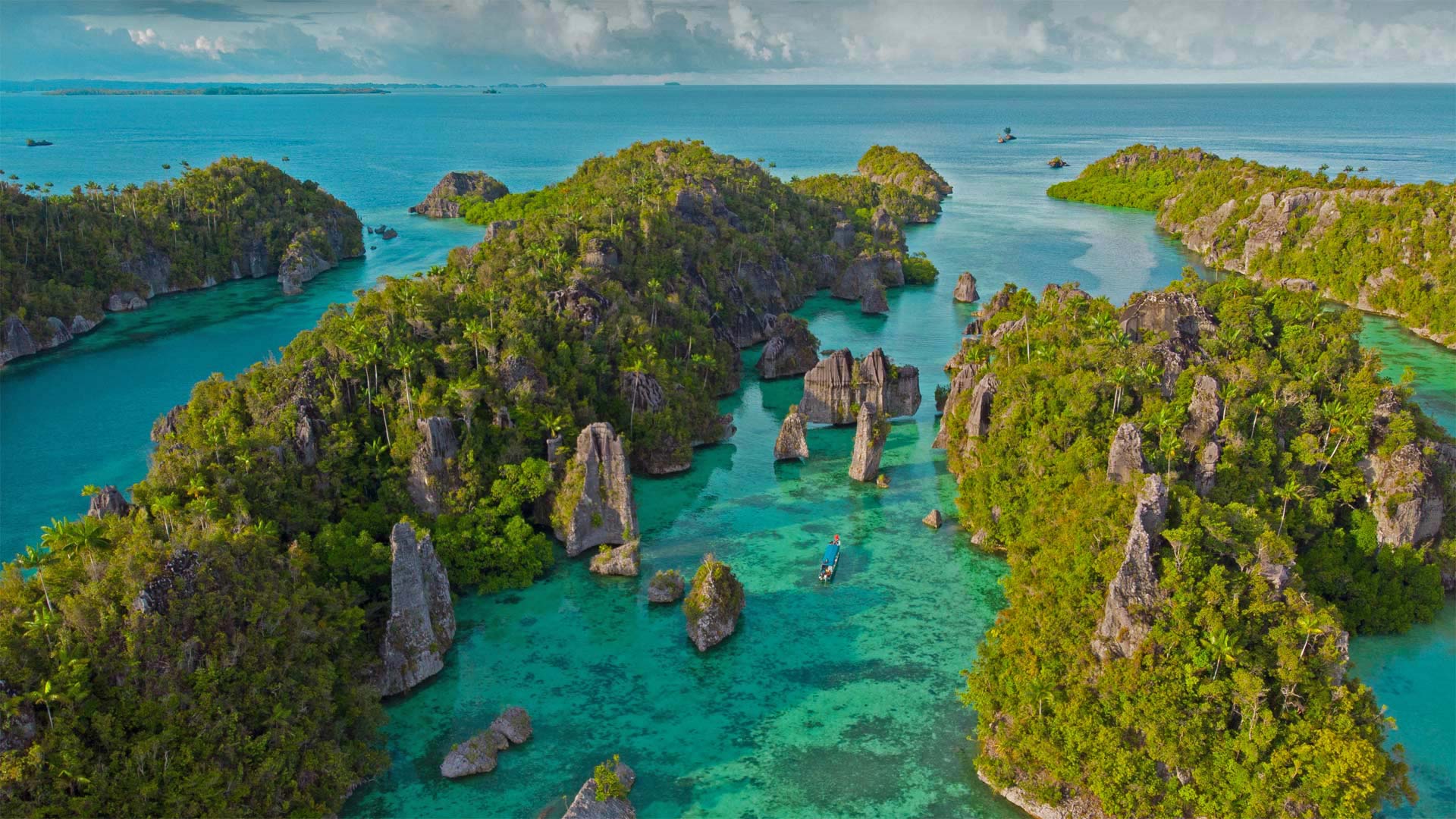
米苏尔岛,拉贾安帕特群岛中的岛屿,印度尼西亚 Misool Island, one of the four major islands in the Raja Ampat Islands in West Papua, Indonesia (© rusm/Getty Images)
一个可供探险的水下天堂 An underwater paradise to explore
Misool Island, Indonesia
You may think finding a tropical paradise that's still largely untouched by people is merely a pipe dream. You may be wrong. Raja Ampat, an archipelago in the province of West Papua, Indonesia, has a mere 50,000 inhabitants, and they all live on or around its four main islands—Batanta, Misool, Salawati, and Waigeo. (In fact, the name Raja Ampat means 'Four Kings' and derives from an ancient legend that says four young kings were hatched from dragon eggs, one ruler for each of those main islands.) The rest of Raja Ampat is made up of about 1,500 smaller islands and cays—and astonishingly, hundreds of these tiny islands have yet to be explored by humans.
Of course, the lack of people is critical to keeping this paradise pristine. The main visitors today tend to be adventurous divers and snorkelers, who love exploring Raja Ampat and its vast reef system. And for good reason: It's considered one of the most biodiverse places in the world. The ecosystem, which is part of a larger tropical ocean area called the Coral Triangle, is so diverse that it's sometimes referred to as 'the Amazon of the seas.' Raja Ampat stretches over nearly 10 million acres of land and sea, and it boasts 540 types of coral, more than 1,000 species of coral reef fish, 700 kinds of mollusks, and a variety of warm-blooded marine animals (including migratory snorkelers and scuba-divers).
印度尼西亚米苏尔岛
你可能会认为,找到一个基本上还没有被人们触及的热带天堂只是一个白日梦。你可能错了。拉贾·安巴特是印尼西巴布亚省的一个群岛,仅有50000名居民,他们都居住在巴坦塔、米苏尔、萨拉瓦蒂和瓦吉奥四个主要岛屿上或周围。(事实上,Raja Ampat这个名字的意思是“四个国王”,来源于一个古老的传说,传说四个年轻的国王是从龙蛋孵化出来的,每个主要岛屿都有一个统治者。)Raja Ampat的其余部分由大约1500个较小的岛屿和珊瑚礁组成,令人惊讶的是,数百个这样的小岛尚未被人类探索。
当然,缺少人对于保持这个天堂的原始状态至关重要。今天的主要游客往往是喜欢冒险的潜水员和浮潜者,他们喜欢探索拉贾安巴特及其巨大的珊瑚礁系统。理由很充分:它被认为是世界上生物多样性最丰富的地方之一。该生态系统是一个称为珊瑚三角洲的较大热带海洋区域的一部分,其多样性如此之大,有时被称为“海洋亚马逊”Raja Ampat占地近1000万英亩,拥有540种珊瑚、1000多种珊瑚礁鱼类、700种软体动物和各种温血海洋动物(包括迁徙的浮潜者和潜水者)。
邓弗里斯和加洛韦的甜心修道院,苏格兰 Sweetheart Abbey, Dumfries and Galloway, Scotland (© Westend61/Getty Images)
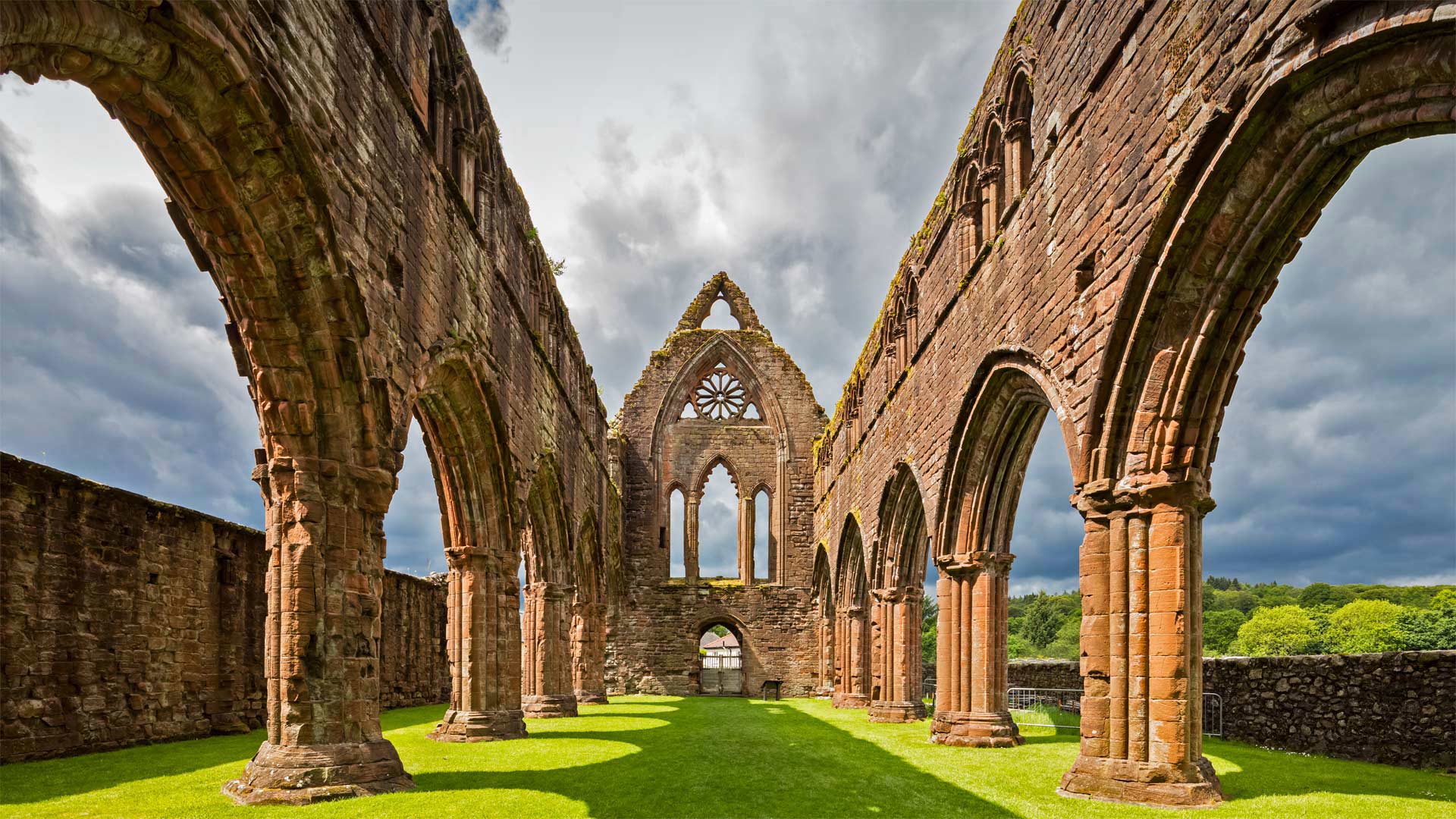
邓弗里斯和加洛韦的甜心修道院,苏格兰 Sweetheart Abbey, Dumfries and Galloway, Scotland (© Westend61/Getty Images)
一场光明正大的示爱 A very public display of affection
Sweetheart Abbey, Scotland
They say Paris is 'the city of love' but there's a lesser-known place where love is the whole reason it even exists. We're in a Scottish village now known as New Abbey, about 6 miles south of Dumfries. We've stepped inside the ruins of Sweetheart Abbey, the testament to a 13th-century love between a husband and wife. Founded in 1273 by 'lady of substance' Dervorguilla of Galloway, the abbey was constructed solely to commemorate her love for English nobleman John de Balliol upon his death in 1268.
Her devotion didn't end there, though. It's said she had his heart embalmed and placed into an ivory casket bound with silver. She then carried it with her everywhere she traveled for the rest of her life. Dervorguilla and the heart were eventually laid to rest alongside John at the abbey when she passed in 1290. As time progressed, sadly, the lovers' graves were lost to war.
The ruins of Sweetheart Abbey aren't the only remnants of this ancient love still standing today. Dervorguilla, far wealthier than her husband, paid off one of his debts after he died by founding Balliol College of the University of Oxford. She also provided the capital for a permanent endowment for the college, which still exists today—the history students' society is even called the Dervorguilla Society.
苏格兰甜心修道院
他们说巴黎是“爱的城市”,但有一个鲜为人知的地方,爱是它存在的全部原因。我们在苏格兰的一个村庄,现在被称为新修道院,位于Dumfries以南约6英里处。我们走进了情人修道院的废墟,这是13世纪夫妻之间爱情的见证。这座修道院于1273年由加洛韦(Galloway)的“物质夫人”德沃吉拉(Dervorguilla)修建,专门纪念她在1268年英国贵族约翰·德·巴利奥尔(JohnDeBalliol)去世后对他的爱。
然而,她的忠诚并没有就此结束。据说她对他的心脏进行了防腐处理,并将其放入一个镶银的象牙棺材中。然后,她把它带到了她余生旅行的每一个地方。1290年,德沃吉拉和心脏最终与约翰一起在修道院安息。随着时间的推移,不幸的是,这对恋人的坟墓被战争夺去了。
甜心修道院的废墟并不是这段古老爱情的唯一遗迹,它至今仍屹立不倒。Dervorguilla比她的丈夫富裕得多,在他去世后,她通过创建牛津大学巴利奥尔学院偿还了他的一笔债务。她还为该学院提供了永久性捐赠资金,该学院至今仍然存在。历史学生协会甚至被称为Dervorguilla协会。
赫尔辛基的哈加杜鹃花公园,芬兰 Haaga Rhododendron Park, Helsinki, Finland (© Samuli Vainionpää/Getty Images)
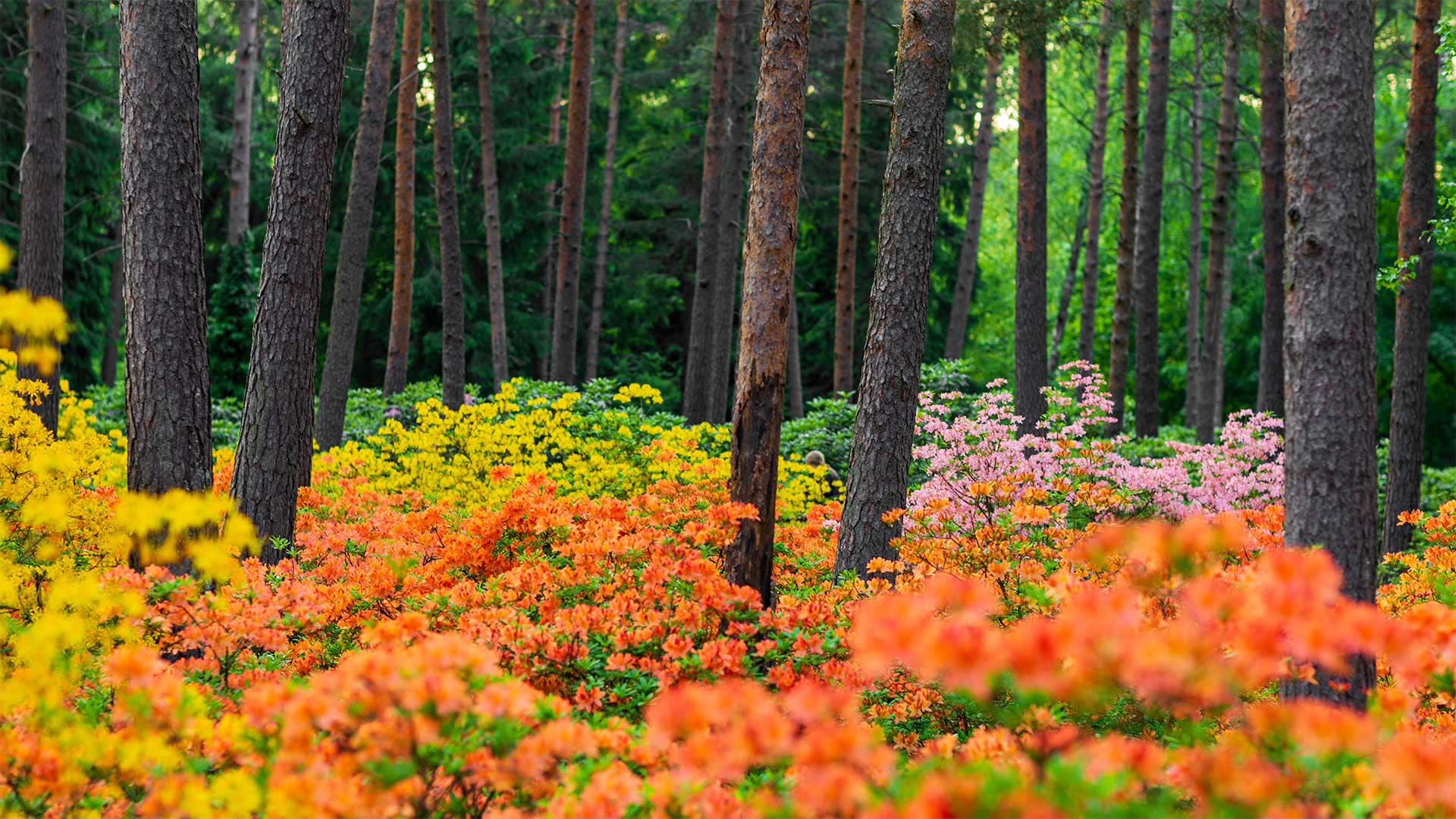
赫尔辛基的哈加杜鹃花公园,芬兰 Haaga Rhododendron Park, Helsinki, Finland (© Samuli Vainionpää/Getty Images)
部分是科研园,部分是公园 Part science experiment, part public park
Haaga Rhododendron Park
In early June, if it's a 'good' year, people in Western Helsinki get treated to bursts of color at the Haaga Rhododendron Park. Started in 1975 as a research location for the University of Helsinki, the plan was to create rhododendron plants that would thrive in Finland's northern climate. And, boy, did they. Around 3,000 specimens of a Japanese variety of rhododendron were originally planted, then selectively bred to produce eight new varieties of 'rhodies' over the years.
In 1996, the park was expanded to include azalea plants which are in the same rhododendron family and bloom at the same time. The research garden now doubles as a public park that is visited by thousands of locals and tourists every summer. Since the gardens were originally planted, it's been observed that the blooms fluctuate. A vibrant year is usually followed by a more modest one. So, if you're 'rhodo-loco' and planning on making the trip to check it out, try to time it right.
哈加杜鹃公园
6月初,如果是“好”的一年,赫尔辛基西部的人们会在哈加杜鹃公园接受突发性的色彩治疗。1975年,作为赫尔辛基大学的研究基地,该计划旨在培育杜鹃花植物,使其在芬兰北部气候条件下茁壮成长。还有,孩子,他们做到了。最初种植了大约3000个日本杜鹃花品种的标本,然后经过多年的选择性培育,培育出8个新的“杜鹃花”品种。
1996年,公园扩建,包括杜鹃花植物,它们属于同一杜鹃科,同时开花。研究园现在兼作公共公园,每年夏天都有成千上万的当地人和游客参观。由于花园最初是种植的,人们观察到花期波动。充满活力的一年之后通常是较为温和的一年。因此,如果你是“rhodo loco”,并计划旅行去看看它,请尽量安排好时间。